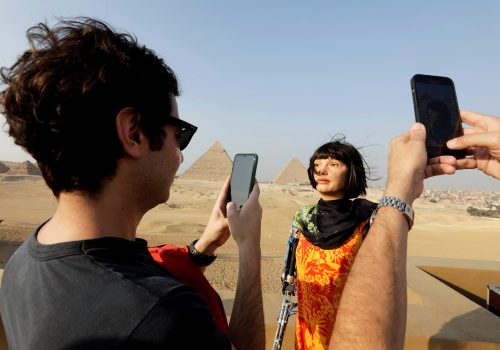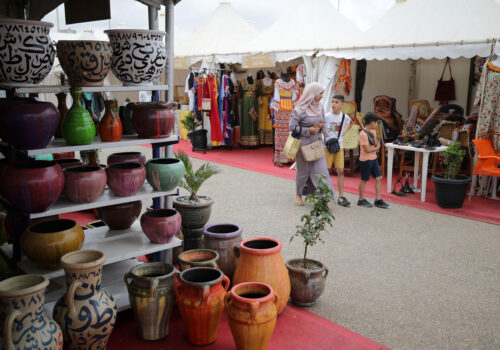What’s behind the Middle East’s doomsday fever?
A group of Iraqi youth secretly gathers in a secluded house in Wasit governorate to carry out an unusual, yet lethal, raffle game. The person whose name is drawn from the pile will need to commit suicide by hanging themselves as a sacrifice, conforming to the group’s sacraments. This is not a scene from a Hollywood movie, but a worrying phenomenon linked to an eschatological sect called Jamaat al-Qurban or the “group of the offerings.”
Five cases of youths committing suicide were recorded in just the first two weeks of June in Wasit alone, according to a recent communiqué issued by the Iraqi National Security Services, which condemned the “deviant” movement and arrested thirty-one of its members. This wasn’t the first incident linked to the sect, which is affiliated with a mysterious leader based in Iran’s holy city of Mashhad claiming to worship Imam Ali, the son-in-law of Prophet Mohammad, as a deity—an unorthodox belief condemned by mainstream Shia clergy. The movement claimed the lives of several young men in Dhi Qar governorate last year, and some reports suggest that it has already spread to other countries including Lebanon, where a young man took his own life in a similar ceremonial ritual in July 2023. Because its epicenter is in Dhi Qar governorate, it is hard not to associate Jamaat al-Qurban with the human sacrifices that took place only twenty miles away in the Sumerian city of Ur some 4,500 years ago.
Collective trauma and messianic creed
Iraq remains a fertile ground for messianic doctrines and often irrational eschatological dogmas due to a mixture of deeply engrained Mesopotamian mythological legacy, pronounced esoteric beliefs associated with the dominant Twelver Shiism creed, and the many minority religious beliefs in the country linked to Gnosticism, such as Mandaeans, Kakais, Shabak, and Kasnazani Sufi order—communities that all still practice ancestral hermetic and mystic rituals.
SIGN UP FOR THIS WEEK IN THE MIDEAST NEWSLETTER
These peculiar incidents—along with the flourishing of tens of other doomsday sects led by self-claimed prophets, charlatans, and characters with a Messiah complex—should be understood as a social phenomenon in the context of a collectively traumatized post-invasion Iraqi society. Repetitive conflicts since 2003 have caused political unrest, sectarian unrest, fragmented state structures, and a suppressed Tishreen social movement—a youth-led protest movement between 2019 and 2021 condemning corruption and asking for less foreign interference—and might offer explanations for why so many Iraqis are plunging into the abyss of obscure metaphysical beliefs after seemingly losing hope in the physical realm.
Despite its apparent resilience and openness to a future with ambitious economic reforms and infrastructure projects, Iraq still suffers from invisible fractures affecting the core of its society. A 2007 national survey revealed that nearly 60 percent of the population experienced traumatic events with next to no access to psychological support—these numbers don’t even take into consideration the ordeal caused by conflict with the Islamic State of Iraq and al-Sham (ISIS). Additionally, the World Health Organization warned about the soaring number of suicide attempts among young Iraqis in 2020.
A savior in a beanie and an Atlantis for the Shia
The United Kingdom, which hosts an important community of Arab refugees and expatriates, is the site of the hours-long live broadcasts by Sheikh Yasser al-Habib. From his headquarters in southern London, the exiled Kuwaiti cleric has been collecting live donations for the purchase of three islands amounting to $3 million, which he will allegedly transform into a sovereign homeland for all Twelver Shia individuals willing to relocate to the promised idyllic Atlantis. The project, announced earlier this year, will be designed in accordance with the sheikh’s religious preachings, and will aim to prepare for the savior’s return from his millennium-long occultation.
Another Iraqi-born doomsday sect, the Ahmadi Religion of Peace and Light—a syncretic faith mixing psychedelic consumption, New Age beliefs, soul reincarnation, ancient Egyptian gods, and space aliens—also calls the United Kingdom home. The movement, formally known as the Black Banners, is currently based in Manchester, where an old orphanage converted into a temple is adorned with a marble statue of a man from Basra called Ahmed al-Hassan al-Yamani, who had proclaimed himself the vizier of the Mahdi amid the chaos that followed the US invasion of Iraq in 2003.
This religion took a new turn when an Egyptian associate of Hassan, Abdullah Hashem, appeared in a black beanie during the pandemic, claiming in a hall full of devotees to be the final Mahdi, prophesizing the political demise of the leaders of Saudi Arabia, Egypt, and Jordan, and condemning the persecution of the movement’s activists across the world. It remains unclear how these movements fund their large-scale events and media presence.
This is but the tip of the iceberg. In recent years, many baffling figures have risen to fame, like Abu Ali Shaibani—a former Iraqi secret services officer and herbalist based in Lebanon, who accurately predicted the assassination of Islamic Revolutionary Guard Corps Quds Force Commander Qasem Soleimani and Abu Mahdi al-Muhandis, the head of the Popular Mobilization Forces—who claims to be the equivalent of a trumpet of Armageddon in the Bible. Other famed charlatans include Diaa Abdu Zahrae al-Garaoui, killed on a farm in Zargha with hundreds of his followers by US coalition forces in 2007 after conspiring to assassinate top Hawza clergy in Najaf. The leader of Jund al-Samaa (“the Soldiers of Heaven”)—Iraq’s own Jim Jones—claimed to be a 1,400-year-old dormant embryo from Imam Ali and his spouse Fatima Zahra, who rose to become the Mahdi.
A larger MENA phenomenon
It is important to note that this phenomenon is part of a larger messianic resurgence across the Middle East and North Africa (MENA) in the past two decades. Cases of self-proclaimed end-of-day prophets emerge every other day on social media, such as an amusing Lebanese fortuneteller “sent from the heavens to save humankind,” who appeared two years ago. However, only a few become full-fledged religious leaders, such as the controversial Yemeni Naser Mohamed, a tribal leader from Marib, or his compatriot Hassan al-Tuhami, who was arrested and tortured by the Houthis with his followers.
This tendency created an entire ecosystem of social media content creators and famed prime-time television clairvoyants like the Egyptian-Lebanese Leila Abdelatif. This new army of influencers interprets the holy scriptures, tracks the signs of the end of days against current regional conflicts like the Gaza war, and projects apocalyptic Islamic protagonists on modern-day political leaders like Hezbollah Secretary General Hassan Nasrallah, Houthi leader Abdul-Malik al-Houthi, Saudi Crown Prince Mohamed Bin Salman, or Egyptian President Abdel Fattah el-Sisi.
Interestingly, similar trends are observed regarding Israel and the Gaza war, fueled by certain Haredi Jewish groups and their US Christian right allies, and by the dichotomous biblical rhetoric promulgated by members of the Israeli government, a coalition that more secular analysts describe as “messianic.” Following the terror generated by the October 7, 2023, attacks, several Israeli officials, including Israeli Prime Minister Benjamin Netanyahu and Yoav Gallant, described the conflict as a holy war between “the sons of lights, and the sons of darkness.” (Though it’s unclear if these statements are mere allegories or discursive tactics used to appeal to an increasingly religious Israeli society.) Another internet and media sensation to follow is the Texas red heifers associated in the scriptures with the building of the Third Temple in Jerusalem and the advent of the Jewish Messiah. As certain far-right Jewish and Christian activists call for conducting a purification ritual using the ashes of the Angus cows on the Temple Mount, where al-Aqsa Mosque stands today, Hamas leadership made a salient declaration associating the ritual with the October 7, 2023, terrorist attacks.
Historically, messianic movements in the MENA region are symptomatic of profound social and economic malaise and are a form of subaltern resistance by frustrated citizens opposing the existing tyrannic political and theological structures. Many messianic leaders even brought immense change and shifted the course of entire empires—like Mahdi ibn Tumart, the founder of the Moroccan Almohad dynasty, or the early Ismaili Fatimid rulers in Tunisia and Egypt. Others were less fortunate, like Juhayman al-Otaybi and his failed 1979 coup d’état in Mecca. Nonetheless, in a region where the borders between the natural and supernatural remain blurred, it is extremely worrisome and premonitory of greater regional upheaval to observe an unprecedented doomsday fever and a high concentration of messianic groups—probably the most important since Prophet Mohammad and Jesus of Nazareth.
Sarah Zaaimi is a cultural studies researcher and the deputy director for communications at the Atlantic Council’s Rafik Hariri Center & Middle East programs.
Further reading
Wed, Aug 9, 2023
I spoke to an AI ‘God.’ We chatted about the ethical implications of artificial intelligence in the MENA
MENASource By Sarah Zaaimi
An artificial intelligence "God" is the tip of the iceberg on the ethical implications of AI use in a socially and culturally complex region.
Thu, May 30, 2024
A war is raging between Algeria and Morocco. It is being fought in the heritage arena.
MENASource By Sarah Zaaimi
As political tensions between Algiers and Rabat have continued to mount since 2020, another front is being fought with no possible détente in sight.
Wed, Dec 14, 2022
Morocco’s World Cup victories are historical revenge for subaltern dreamers from the global south
MENASource By Sarah Zaaimi
The defeat-free journey of the Moroccan soccer national team, the Atlas Lions, is more than a simple sports score.
Image: Iraqi Shiite Muslims pray at the Imam Abbas shrine in Iraq's holy city of Karbala, ahead of Ashura day, the tenth day of the month of Muharram. Muharram is considered a month of mourning and remembrance for Shiite Muslims around the world, in which they commemorate the martyrdom of the grandson of the Islamic prophet Mohammad, Husayn ibn Ali, who was killed in the 7th century Battle of Karbala. via Reuters


